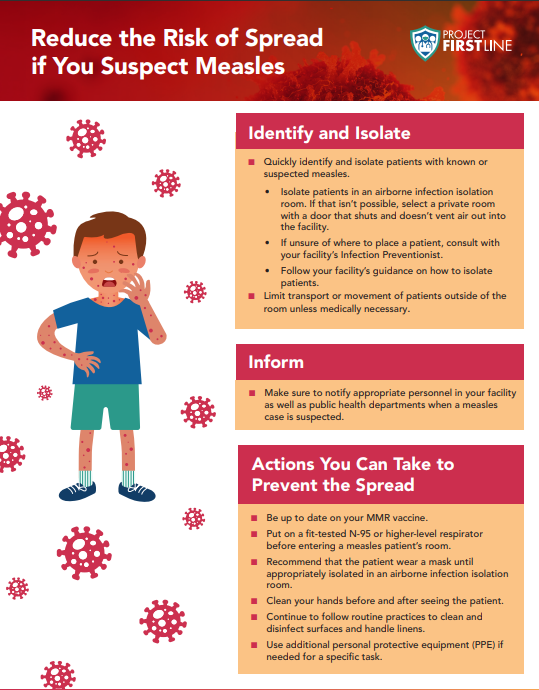
Share On Social!
Infection control training and action is crucial for healthcare workers.
With this in mind, check out the Infection Control Micro-Learns from the Project Firstline program of the U.S. Centers for Disease Control and Prevention (CDC). Micro-learns are a series of guided infection control discussions that can be easily incorporated into team meetings or huddles led by an experienced team member with infection control expertise.
Each micro-learn focuses on a single infection control topic and connects these concepts to immediate, practical value.
Measles is one of the most contagious infectious diseases and can lead to severe illness and even death.
Let’s explore the Infection Control Micro-Learns on Measles.
What Does Measles Look Like?
Measles is a respiratory virus.
Measles virus lives in the nose and throat of infected people. It can spread to others through the air, remaining infectious in the air for up to two hours after an infected person leaves the area.

Early symptoms can seem like a common cold and include:
- fever
- cough
- runny nose
- red, watery eyes
- and/or tiny white spots in the mouth
Additionally, a rash generally occurs three to five days after symptoms begin and usually appears on the face and behind the ears first and then spreads down the body.
Healthcare workers should assume a patient has measles if they have measles symptoms and have at least one of the following:
- Spent time in an area in the U.S. with a known measles outbreak
- Recently been around someone else with measles
- Traveled internationally in the last 21 days
- Not been vaccinated for measles or don’t know their vaccination status
The CDC notes that if a healthcare worker’s facility is located in an area where measles is known to be spreading, anyone with measles symptoms should be considered to have measles until you can rule it out.
What Should You Do When You Have a Patient with Measles?
It’s crucial to quickly identify and isolate patients with known or suspected measles, as well as assess, test, and manage patients in an airborne infection isolation room.
If that isn’t possible, select a private room with a door that shuts and doesn’t vent air into the facility. Limit transport or movement of patients outside of the room unless medically necessary.
Next, make sure to notify appropriate personnel in your facility, as well as public health departments, when a measles case is suspected.
Additional actions to prevent the spread are:
- Be up to date on your MMR vaccine.
- Put on a fit-tested N-95 or higher-level respirator before entering a measles patient’s room. Recommend that the patient wear a mask until appropriately isolated in an airborne infection isolation room.
- Clean your hands before and after seeing the patient.
- Continue to follow routine practices to clean and disinfect surfaces and handle linens.
- Use additional personal protective equipment (PPE) if needed for a specific task.
What Can You Do to Promote Infection Control in Your Healthcare Setting?
Help keep yourself, your colleagues, and your patients safe from infectious disease threats by building on your infection control knowledge!
To show your dedication, sign this pledge to complete an infection control training or activity through CDC’s Project Firstline!
You can also share infection control training opportunities with healthcare colleagues via LinkedIn with our Project Firstline social media toolkit.
Access more information about infection prevention and control in healthcare by visiting resources from CDC Project Firstline.
Salud America! at UT Health San Antonio is working with the National Hispanic Medical Association to bring Project Firstline infection control educational content to healthcare workers, so they are equipped with the knowledge they need to protect themselves, their facilities, and their patients (Latinos and all communities) from infectious disease threats in healthcare settings.
Check out more micro-learns from the partnership:
Check out some of the articles from this partnership:
- What is Project Firstline?
- What is the Goal of Infection Prevention and Control in Healthcare Settings?
- What is Ventilation and Why Does It Matter?
- Contact Time: What is It and How Does it Impact Infection Control?
- The Surprising Difference Between Cleaning and Disinfection
- What’s a Respiratory Droplet and Why Does It Matter?
Check out some healthcare workers who are heroes for infection control:
- Anna Valdez: Tackling Infection Control with Education from Classroom to Clinic
- Wanda Montalvo: Preventing Infections in Community Health Centers, Latino Communities
- Ricardo Correa: Endocrinologist and Infection Control Leader for the Latino Community
- Jorge Moreno: Infection Control Hero for Spanish-Speaking Latinos and All Patients
- Veronica Ramirez: Keeping Her Community Health with Infection Control
- Juanita Mora: A Voice for the Latino Community and Infection Control
LEARN MORE ABOUT PROJECT FIRSTLINE!
Editor’s Note: This article is part of a collaboration between Salud America!, the National Hispanic Medical Association, and the CDC’s Project Firstline. To find resources training materials, and other tools to bolster knowledge and practice of infection control, visit Project Firstline and view Salud America!’s infection control content.
By The Numbers
142
Percent
Expected rise in Latino cancer cases in coming years



